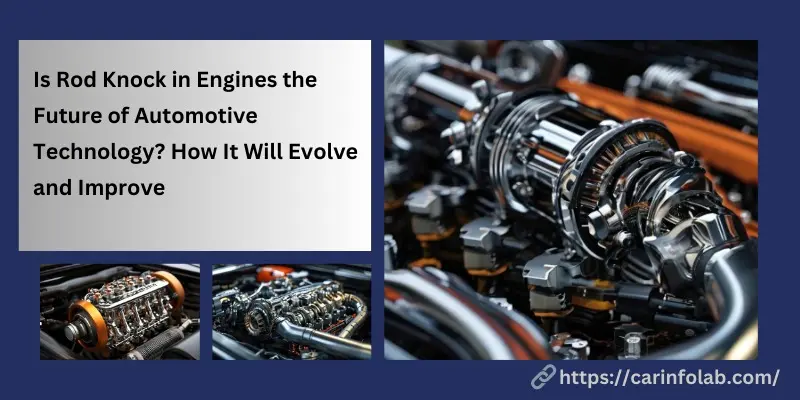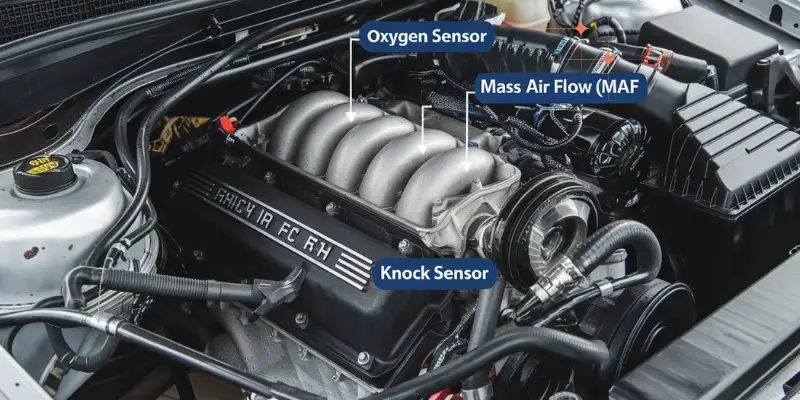Is Rod Knock in Engines the Future of Automotive Technology? How It Will Evolve and Improve
Updated: September 7, 2024
91
When it comes to car engines, one of the common issues that many drivers worry about is rod knock in Engines. This problem can seem quite daunting if you’re not familiar with engine mechanics. Don’t oversight System Fault in the vehicle. In this article, we’ll break down what rod knock is, how it affects your engine, and whether it could have any implications for future automotive technology.
What is Rod Knock?
Rod knock is a noise that comes from your engine when a part called the connecting rod, which connects the piston to the crankshaft, starts to fail. It usually sounds like a knocking or banging noise coming from the engine.

Causes of Rod Knock
Rod knock happens due to a few main reasons:
| Causes |
|---|
|
Preventive Measures
To avoid rod knock, consider these preventive steps:
| Tips |
|---|
|
Rod Knock and Automotive Technology
You might wonder, how does rod knock fit into the future of automotive technology? Well, while rod knock is a problem we deal with today, advancements in technology are working to address such issues.
Advances in Engine Design
1. Improved Bearing Materials
Bearings are crucial components in an engine that support the rotating parts, such as the crankshaft and connecting rods. They reduce friction and wear between these moving parts.
- Advanced Materials: Modern bearings are made from advanced materials like composites and high-strength alloys that are more durable and resistant to wear and tear.
- Enhanced Lubrication: New bearing designs incorporate improved lubrication systems that help reduce friction and extend the life of the bearings.
Benefits:
- Reduced Friction: Lower friction means less heat generation and improved engine efficiency.
- Longer Lifespan: Enhanced materials and lubrication contribute to a longer bearing life, reducing the likelihood of issues like rod knock.
2. Variable Valve Timing (VVT)
Variable Valve Timing is a technology that allows the timing of the valve openings and closings to be adjusted based on the engine’s speed and load.
- Advanced Mechanisms: Modern VVT systems use electronic controls and hydraulic actuators for precise timing adjustments.
- Dual VVT: Some engines use dual VVT, which allows both the intake and exhaust valves to be controlled independently for better performance.
Benefits:
- Improved Efficiency: VVT optimizes engine performance and fuel efficiency across different speeds and loads.
- Better Emissions: It helps in reducing emissions by improving the combustion process.
3. Turbocharging
Turbocharging uses a turbine-driven forced induction system to increase the engine’s power output by forcing more air into the combustion chamber.
- Smaller Turbochargers: Modern turbochargers are more compact and efficient, providing high performance without increasing engine size.
- Variable Geometry Turbochargers: These turbochargers have adjustable vanes that optimize airflow for different engine speeds, improving responsiveness and efficiency.
Benefits:
- Increased Power: Turbocharging allows for a smaller engine to produce more power, enhancing vehicle performance.
- Better Fuel Economy: It can lead to better fuel efficiency as a smaller, turbocharged engine can replace a larger, less efficient one.
4. Direct Fuel Injection
Direct fuel injection is a technology where fuel is injected directly into the combustion chamber under high pressure, rather than mixing with air in the intake manifold.
- High-Pressure Systems: Newer systems use higher fuel pressures for better atomization and combustion.
- Multiple Injection Strategies: Some engines use multiple injections per cycle for improved performance and efficiency.
Benefits:
- Enhanced Efficiency: Direct fuel injection improves fuel atomization and combustion efficiency, leading to better fuel economy.
- Reduced Emissions: It helps in reducing emissions by ensuring a more complete combustion of the fuel.
5. Advanced Engine Cooling Systems
Cooling systems maintain the engine temperature within an optimal range to prevent overheating.
- Variable Capacity Water Pumps: Modern cooling systems use variable capacity pumps that adjust the flow of coolant based on engine temperature and load.
- Improved Radiators: New radiator designs offer better heat dissipation and are more efficient.
Benefits:
- Better Temperature Control: Advanced cooling systems help in maintaining optimal engine temperatures, preventing overheating and potential damage.
- Increased Efficiency: Efficient cooling systems improve overall engine performance and longevity.
6. Lightweight Materials
Lightweight materials, such as aluminum and carbon composites, are used in engine components to reduce weight without compromising strength.
- High-Strength Alloys: New alloys offer improved strength-to-weight ratios, making engine components lighter and more durable.
- Composite Materials: Advanced composites reduce weight and enhance performance while maintaining structural integrity.
Benefits:
- Enhanced Performance: Lighter engines contribute to better vehicle handling and acceleration.
- Improved Fuel Economy: Reduced engine weight can lead to better fuel efficiency.
Role of Sensors and Diagnostics in Modern Engines
Sensors and diagnostic tools are vital for keeping engines running smoothly. They help spot problems early and make sure everything works well.
| Sensor/Tool | Function |
|---|---|
| Oxygen Sensors | Check how much oxygen is in the exhaust gases. |
| Mass Air Flow (MAF) Sensor | Measures how much air is going into the engine. |
| Knock Sensors | Detects engine knocking and adjusts timing to prevent damage. |
| Coolant Temperature Sensor | Monitors the temperature of the engine’s coolant. |
| Fuel Level Sensor | Measures how much fuel is in the tank. |
| Transmission Fluid Temperature Sensor | Measures the temperature of the transmission fluid. |
| Speed Sensors | Tracks the speed of the wheels or transmission. |
| On-Board Diagnostics (OBD-II) | Reads error codes and monitors engine systems. |
| Diagnostic Scan Tool | Connects to the OBD-II port to read error codes and monitor data. |
| Traction Control Sensors | Detects if wheels are spinning and adjusts engine electrical power or braking to keep traction. |
Electric and Hybrid Engines
Electric and hybrid engines don’t use traditional internal combustion engines. Therefore, they don’t have the same issues as conventional engines, including rod knock. Advancements in technology are addressing the Ford Sync black screen issue, leading to more reliable infotainment systems.

These new technologies could represent the future of automotive power.
- Better Battery Efficiency: Batteries will charge faster and last longer, increasing range and reducing recharge time.
- Improved Regenerative Braking: Enhanced systems will capture more energy from braking to extend driving range.
- Wireless Charging: Future EVs will charge without plugging in, making recharging more convenient.
- AI and Machine Learning: These technologies will optimize battery use and driving patterns for better efficiency.
- Lightweight Materials: Using lighter materials will boost efficiency and performance.
- Better Thermal Management: Improved systems will keep electric motors and batteries at the right temperature for longer life.
- Vehicle-to-Grid (V2G): EVs will provide power back to the grid, helping balance energy demand.
Industry Perspectives on Rod Knock
People who know a lot about cars have different opinions about rod knock. Some think it’s a problem that we need to keep fixing, while others think it’s a good challenge that makes us come up with new ideas.
Everyone agrees that fixing rod knock and making engines last longer is important for cars to get better. Advancements in technology are addressing issues like when a car makes a clicking noise while accelerating, leading to smoother and more reliable performance.
Conclusion
Rod knock in engines is a significant issue that can lead to engine damage and costly repairs, including issues like Chevy 6.6 gas problems. However, advancements in technology are helping to address these issues. Modern engines are better designed, and diagnostic tools are more advanced, which helps in preventing and identifying problems early. As automotive technology continues to evolve, we might see even more improvements that could reduce or eliminate problems like rod knock.
Advancements in Ford F150’s diagnostics now pinpoint issues more precisely when the wrench light is on. For now, staying on top of your vehicle’s maintenance is the best way to prevent rod knock and keep your engine running smoothly.
FAQs
Can rod knock in engines be repaired?
Yes, by replacing damaged bearings and related parts.
What kind of oil should be used to prevent rod knock in engines?
Use high-quality oil that meets your vehicle’s specifications.
Can rod knock in engines be caused by poor driving habits?
Yes, habits like rapid acceleration and hard braking can contribute to rod knock.
Does rod knock in engines affect fuel efficiency?
Yes, it can lower fuel efficiency due to rough engine operation.
Is rod knock in engines a serious problem?
Yes, it can lead to severe engine damage if not fixed.
Please Write Your Comments